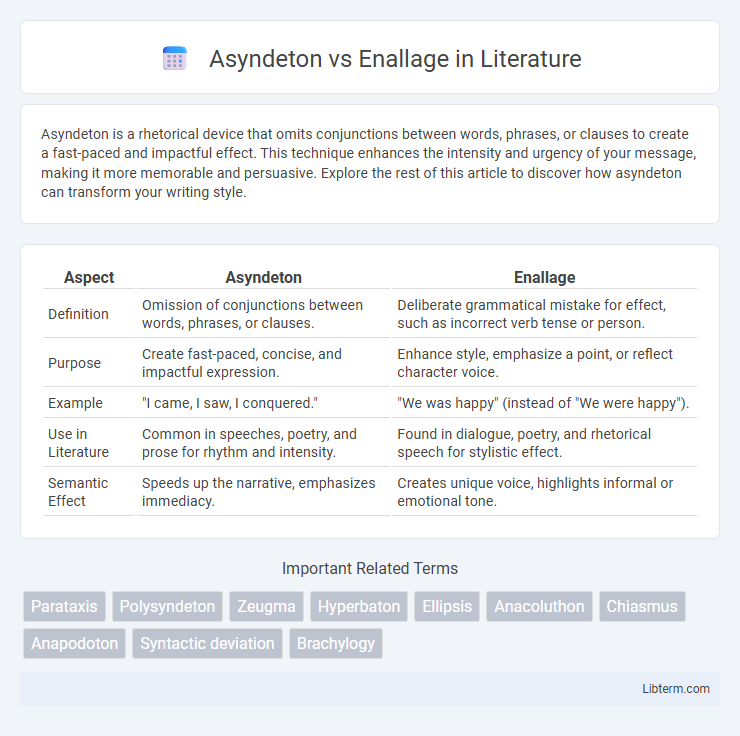Asyndeton is a rhetorical device that omits conjunctions between words, phrases, or clauses to create a fast-paced and impactful effect. This technique enhances the intensity and urgency of your message, making it more memorable and persuasive. Explore the rest of this article to discover how asyndeton can transform your writing style.
Table of Comparison
| Aspect | Asyndeton | Enallage |
|---|---|---|
| Definition | Omission of conjunctions between words, phrases, or clauses. | Deliberate grammatical mistake for effect, such as incorrect verb tense or person. |
| Purpose | Create fast-paced, concise, and impactful expression. | Enhance style, emphasize a point, or reflect character voice. |
| Example | "I came, I saw, I conquered." | "We was happy" (instead of "We were happy"). |
| Use in Literature | Common in speeches, poetry, and prose for rhythm and intensity. | Found in dialogue, poetry, and rhetorical speech for stylistic effect. |
| Semantic Effect | Speeds up the narrative, emphasizes immediacy. | Creates unique voice, highlights informal or emotional tone. |
Introduction to Asyndeton and Enallage
Asyndeton is a rhetorical device that omits conjunctions between words or phrases to create a concise, impactful statement, enhancing rhythm and urgency. Enallage involves deliberately using incorrect grammar or syntax, such as shifts in person, tense, or number, to add emphasis or character voice. Both techniques serve distinct stylistic purposes in literature and speech to manipulate sentence structure and meaning.
Defining Asyndeton: Meaning and Examples
Asyndeton is a rhetorical device characterized by the deliberate omission of conjunctions between words, phrases, or clauses to create a concise and impactful expression. Common examples include Julius Caesar's "Veni, vidi, vici," which translates to "I came, I saw, I conquered," illustrating the effect of rapid succession without conjunctions. This technique enhances the rhythm and intensity of speech or writing by removing connecting words, making statements more memorable and persuasive.
Understanding Enallage: Meaning and Usage
Enallage is a rhetorical device involving the deliberate misuse or variation of grammar, particularly verb tense, person, or number, to create a stylistic effect or convey a specific tone. Unlike asyndeton, which omits conjunctions to enhance the flow and speed of a sentence, enallage specifically alters grammatical structures to add emphasis or character voice. Understanding enallage involves recognizing its function as a method of linguistic substitution that enriches expression by breaking conventional grammatical rules.
Historical Origins of Asyndeton and Enallage
Asyndeton, rooted in ancient Greek rhetoric, originated as a stylistic device employed by classical orators like Demosthenes to create emphasis and rhythm by omitting conjunctions between clauses. Enallage, emerging from the study of Greek grammar and later Latin literature, involves intentional grammatical shifts to convey a speaker's character or enhance persuasive impact. Both devices have been integral to classical literary traditions, influencing oratory and poetic techniques throughout Western history.
Grammatical Structure Differences
Asyndeton involves the deliberate omission of conjunctions between words, phrases, or clauses to create a concise and impactful sentence structure, enhancing rhythm and emphasis. Enallage, on the other hand, is a grammatical shift in person, number, tense, or mood within a sentence to produce a stylistic effect or convey a specific voice. The key difference lies in asyndeton manipulating coordination and linkage by removing conjunctions, while enallage alters verb forms or pronouns to disrupt standard grammatical agreement.
Stylistic Effects in Literature
Asyndeton creates a rapid, impactful rhythm by omitting conjunctions, enhancing tension or urgency in literary works. Enallage involves deliberate grammatical variations, like shifting verb moods or pronouns, to add character depth or highlight internal conflicts. Both stylistic devices intensify emotional resonance and shape narrative voice by manipulating sentence structure for distinct rhetorical effects.
Usage in Rhetoric and Speechwriting
Asyndeton enhances rhetoric and speechwriting by omitting conjunctions between words or phrases, creating a concise, dramatic effect that accelerates rhythm and emphasizes key ideas. Enallage involves intentional grammar or syntax errors, such as shifting person or tense, to produce a striking, memorable impact that engages the audience emotionally. Both techniques serve strategic functions: asyndeton streamlines expression and intensifies urgency, while enallage introduces deliberate linguistic variation to capture attention and convey nuanced tone.
Common Misconceptions and Confusions
Asyndeton and enallage are often confused due to their association with sentence structure, but they serve distinct functions: asyndeton involves omitting conjunctions between phrases or clauses to create a fast-paced rhythm, while enallage is the deliberate misuse of grammar for stylistic effect, such as changing verb tense or person. A common misconception is that both always enhance brevity; however, enallage primarily alters voice or perspective rather than condensing content. Understanding the difference clarifies their unique roles in rhetoric and literary analysis, preventing misidentification in textual interpretation.
Influence on Reader Perception
Asyndeton, which omits conjunctions between phrases, accelerates the rhythm of the text and creates a sense of urgency or intensity, influencing readers to perceive statements as forceful and impactful. Enallage, involving deliberate grammatical shifts such as tense or person changes, prompts readers to engage more deeply by drawing attention to the altered form and emphasizing certain ideas or emotions. Both rhetorical devices shape reader perception by manipulating sentence structure, with asyndeton evoking immediacy and enallage encouraging reflection or highlighting contrast.
Choosing Between Asyndeton and Enallage
Choosing between asyndeton and enallage depends on the desired rhetorical effect; asyndeton creates a rapid, impactful rhythm by omitting conjunctions, while enallage involves intentional grammatical shifts for stylistic emphasis or character voice. Writers prioritize asyndeton to convey urgency or intensity and select enallage to highlight character traits or to introduce linguistic variety. Understanding the context and purpose of a sentence guides the effective use of these figures of speech in literature and speech.
Asyndeton Infographic

 libterm.com
libterm.com